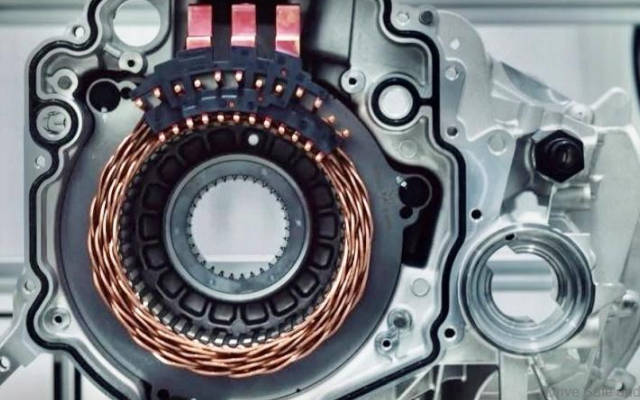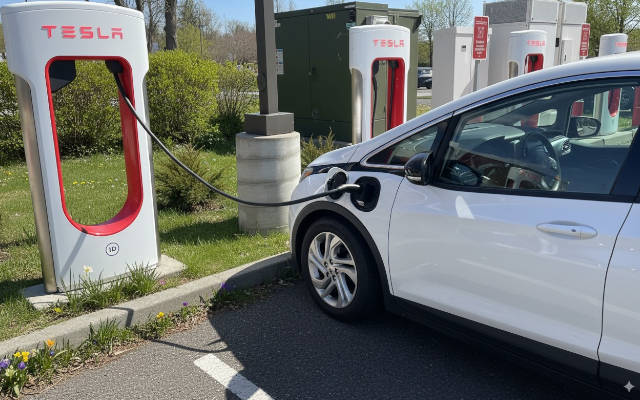 EDITOR'S PICK
EDITOR'S PICK
Rivian's Maximus Drive Unit Boosts R2 SUV Power Density & Manufacturing Efficiency
30 Aug 2025 | Synopsis
 Rivian's Maximus drive unit, launching with the R2 SUV in early 2026, boosts power density by 40% over previous models. It’s smaller, lighter, and easier to manufacture thanks to a simplified stator, integrated cooling and electronics, and fewer fasteners. A redesigned wiring harness further streamlines production, reduces weight enhancing scalability and efficiency.
Rivian's Maximus drive unit, launching with the R2 SUV in early 2026, boosts power density by 40% over previous models. It’s smaller, lighter, and easier to manufacture thanks to a simplified stator, integrated cooling and electronics, and fewer fasteners. A redesigned wiring harness further streamlines production, reduces weight enhancing scalability and efficiency.The Biggest Untold Story of 2025: Energy Fragility and Economic Risk
29 Aug 2025 | Synopsis
 A deepening energy crisis is quietly reshaping global stability. Aging infrastructure, declining EROEI, and financial overextension expose systemic vulnerabilities. As oil production plateaus and economic models falter, the risks of supply shocks and cascading failures grow. Chris Martenson—economic researcher and creator of The Crash Course—guides viewers through this urgent, underreported threat, rekindling the long denigrated "Peak Oil" debate
A deepening energy crisis is quietly reshaping global stability. Aging infrastructure, declining EROEI, and financial overextension expose systemic vulnerabilities. As oil production plateaus and economic models falter, the risks of supply shocks and cascading failures grow. Chris Martenson—economic researcher and creator of The Crash Course—guides viewers through this urgent, underreported threat, rekindling the long denigrated "Peak Oil" debateBMW Just Cranked Out Its 3 Millionth Electrified Vehicle
28 Aug 2025 | Synopsis
 BMW has built its 3 millionth electrified vehicle - a 330e plug-in hybrid assembled in Munich. This milestone includes both EVs and plug-in hybrids. In the first half of 2025, over 25% of BMW's global deliveries were electrified. The company also recently produced its 1.5 millionth fully electric vehicle, a Mini Countryman SE. BMW expects electrified sales to keep growing as part of its tech-neutral strategy.
BMW has built its 3 millionth electrified vehicle - a 330e plug-in hybrid assembled in Munich. This milestone includes both EVs and plug-in hybrids. In the first half of 2025, over 25% of BMW's global deliveries were electrified. The company also recently produced its 1.5 millionth fully electric vehicle, a Mini Countryman SE. BMW expects electrified sales to keep growing as part of its tech-neutral strategy.EV Adoption Stymied By Curious American Trait: Garage Clutter
28 Aug 2025 | Synopsis
 Telemetry's 2025 EV Charging Market Report reveals a surprising barrier to electrification: junky garages. One-third of U.S. homeowners can’t park in their own garages, limiting access to Level 2 charging. With 80% of EV charging done at home, cluttered spaces and costly installations threaten adoption. The report urges behavioral shifts and infrastructure investment to close the equity gap.
Telemetry's 2025 EV Charging Market Report reveals a surprising barrier to electrification: junky garages. One-third of U.S. homeowners can’t park in their own garages, limiting access to Level 2 charging. With 80% of EV charging done at home, cluttered spaces and costly installations threaten adoption. The report urges behavioral shifts and infrastructure investment to close the equity gap.Own a Bolt? Here Is How You Can Supercharge Today
28 Aug 2025 | Synopsis
 Chevy Bolt owners can now access Tesla Superchargers using GM's NACS-to-CCS adapter. After purchasing the dongle ($200–$300), download the Tesla app, link a payment method, and locate compatible stations. Charging to 80% costs around $20–$26. The adapter plugs into the Bolt’s front-left port, and etiquette matters—never block multiple stalls. This marks a major step toward EV charging interoperability and convenience.
Chevy Bolt owners can now access Tesla Superchargers using GM's NACS-to-CCS adapter. After purchasing the dongle ($200–$300), download the Tesla app, link a payment method, and locate compatible stations. Charging to 80% costs around $20–$26. The adapter plugs into the Bolt’s front-left port, and etiquette matters—never block multiple stalls. This marks a major step toward EV charging interoperability and convenience.
 EVWorld Exclusive
EVWorld Exclusive
Unlocking Heat's Hidden Potential: How a Nanoscale Discovery Could Transform Everyday Tech
24 Oct 2025 |  A recent nanoscale physics breakthrough reveals heat can transfer across tiny gaps far more efficiently than expected - up to 100 times greater than classical predictions. This could revolutionize cooling and energy systems in electronics, EVs, and smart appliances. While engineering challenges remain, early applications may emerge within 3-5 years, with broader consumer adoption possible in the next decade. The future of heat management may be silent, solid-state, and radically efficient.
A recent nanoscale physics breakthrough reveals heat can transfer across tiny gaps far more efficiently than expected - up to 100 times greater than classical predictions. This could revolutionize cooling and energy systems in electronics, EVs, and smart appliances. While engineering challenges remain, early applications may emerge within 3-5 years, with broader consumer adoption possible in the next decade. The future of heat management may be silent, solid-state, and radically efficient.
Turning the Energy Crunch into a Smart Grid Revolution
24 Oct 2025 |  America's energy crunch is not about supply - it's about coordination. Virtual power plants and vehicle-to-grid systems offer a scalable, software-driven solution to rising demand from AI, EVs, and climate volatility. By turning homes, vehicles, and businesses into active grid assets, and aligning policy with technology, the U.S. can build a smarter, more resilient energy future without building more power plants. The tools exist - now it's time to connect them.
America's energy crunch is not about supply - it's about coordination. Virtual power plants and vehicle-to-grid systems offer a scalable, software-driven solution to rising demand from AI, EVs, and climate volatility. By turning homes, vehicles, and businesses into active grid assets, and aligning policy with technology, the U.S. can build a smarter, more resilient energy future without building more power plants. The tools exist - now it's time to connect them.
Auto Retail in 2025: Bridging the Trust Gap Between Dealers and Buyers
24 Oct 2025 |  The 2025 Urban Science and Harris Poll report reveals a growing disconnect between dealers and buyers. While dealers embrace EVs, AI, and digital tools, many buyers remain cautious - especially about full electrification and online-only retail. Brand loyalty is weakening, and policy clarity is key to adoption. The future of auto retail depends on bridging trust, flexibility, and infrastructure gaps.
The 2025 Urban Science and Harris Poll report reveals a growing disconnect between dealers and buyers. While dealers embrace EVs, AI, and digital tools, many buyers remain cautious - especially about full electrification and online-only retail. Brand loyalty is weakening, and policy clarity is key to adoption. The future of auto retail depends on bridging trust, flexibility, and infrastructure gaps.
Electric Icons in the Making: Audi Concept C vs. Chevrolet Corvette EV
23 Oct 2025 |  Audi's Concept C previews a refined electric GT built on the mature PPE platform, likely arriving by 2026. Chevrolet's Corvette EV promises supercar performance but faces packaging and thermal challenges. Audi is closer to production; Corvette remains in early development. Both reflect divergent strategies in electrifying legacy sports cars, with Audi emphasizing platform maturity and Chevrolet pursuing brand continuity through engineering innovation.
Audi's Concept C previews a refined electric GT built on the mature PPE platform, likely arriving by 2026. Chevrolet's Corvette EV promises supercar performance but faces packaging and thermal challenges. Audi is closer to production; Corvette remains in early development. Both reflect divergent strategies in electrifying legacy sports cars, with Audi emphasizing platform maturity and Chevrolet pursuing brand continuity through engineering innovation.
Electrification Is Not an Oversimplification
23 Oct 2025 |  Despite critiques that the quest for global electrification is "simplistic", the transition is strategic and necessary. Grid upgrades, battery innovation, and tailored policies make electrification viable. Sodium-ion batteries and recycling reduce material risk. Compared to fossil fuels, electrification offers cleaner, safer, and more resilient systems. Complexity demands better design - not delay.
Despite critiques that the quest for global electrification is "simplistic", the transition is strategic and necessary. Grid upgrades, battery innovation, and tailored policies make electrification viable. Sodium-ion batteries and recycling reduce material risk. Compared to fossil fuels, electrification offers cleaner, safer, and more resilient systems. Complexity demands better design - not delay.
 24 Oct 2025 21:43:45 UTC |
RECENT PODCASTS
What Battery Chemistry Wins - Ontario Nuclear Investment - Battery Storage Boom
SEARCH RSSTREAM
 56 New Postings In Past 24 Hours
56 New Postings In Past 24 Hours
Category:mobility
Region:NoAmerica
Date:24 Oct 2025
Category:mobility
Region:NoAmerica
Date:24 Oct 2025
Category:mobility
Region:NoAmerica
Date:24 Oct 2025
Category:mobility
Region:NoAmerica
Date:24 Oct 2025
Category:finance
Region:NoAmerica
Date:24 Oct 2025
Category:mobility
Region:NoAmerica
Date:24 Oct 2025
Category:finance
Region:NoAmerica
Date:24 Oct 2025
Category:finance
Region:NoAmerica
Date:24 Oct 2025
Category:mobility
Region:NoAmerica
Date:24 Oct 2025
Category:mobility
Region:AsiaPacific
Date:24 Oct 2025
Category:mobility
Region:AsiaPacific
Date:24 Oct 2025
Category:mobility
Region:AsiaPacific
Date:24 Oct 2025
Category:finance
Region:NoAmerica
Date:24 Oct 2025
Category:finance
Region:AsiaPacific
Date:24 Oct 2025
Category:mobility
Region:AsiaPacific
Date:24 Oct 2025
Category:energy
Region:IndoAsia
Date:24 Oct 2025
Category:mobility
Region:IndoAsia
Date:24 Oct 2025
Category:review
Region:AustralPacific
Date:24 Oct 2025
Category:mobility
Region:Europe
Date:24 Oct 2025
Category:mobility
Region:NoAmerica
Date:24 Oct 2025